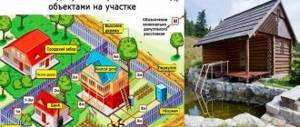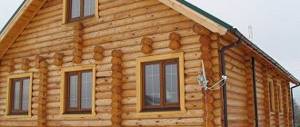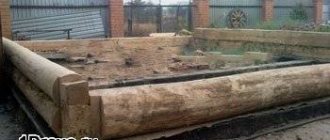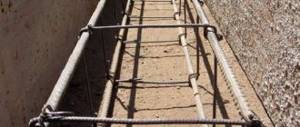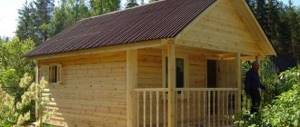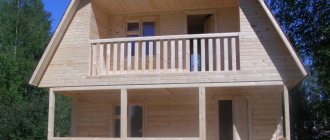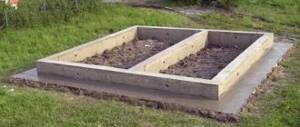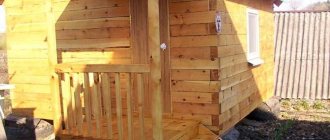Selection and technology of building a foundation for a bathhouse.
A modern bathhouse is a lightweight structure made of logs or timber that can stand on any type of foundation.
When choosing a foundation, you need to take into account the characteristics of the soil on the site and economic feasibility - extremely reliable foundations made of a monolithic slab or reinforced concrete piles for a small bathhouse with an area of up to 6x6 m will simply be unnecessary. Installation of a log bathhouse on the foundation.
Bathhouse on a strip foundation.
In this article we will look at the optimal types of foundations for a bathhouse, give recommendations on their calculation and DIY technology. Strip, columnar, screw and slab foundations, as well as cheap tire foundations, will be examined in detail.
Self-installation of a log house
Installing a log bathhouse with your own hands is something that someone who has made the foundation for it himself may well be able to do. So, after work with the base is completed, it needs to be given some time to stand. At least this should be a week. The standing time is determined depending on the air temperature, time of year and air humidity.
The next stage is the manufacture and preparation of the log house. The best wood for a bathhouse is considered to be winter wood, which is characterized by high levels of durability and strength. This type of work can take from 10 to 45 days. This question depends entirely on the project and size of the log house. And, naturally, manual assembly will take much longer than industrial assembly.
We suggest you read: How to make a door from boards with your own hands
After making the log house, it is necessary to begin assembling it on a ready-made and stable foundation. You can cut logs into a bowl or into a paw. Both of these technologies are time-tested and reliable and durable. At the same time, primary caulking is carried out. Since there are many types of materials for insulation, the assembly time for a log house can range from 10 to 40 days.
Choosing a foundation for a bathhouse.
When choosing which foundation is best for a bathhouse, you need to consider three factors:
- weight and size characteristics of the structure;
- geological conditions on the site - presence of a slope, type of soil and its bearing capacity, freezing depth and groundwater level;
- budget allocated for construction.
In most cases, the best option would be a strip foundation for a bathhouse . The different depths of the strip foundation allow you to build in any soil conditions - on stable soil it is rational to construct a shallow strip (deepened by 30-80 cm), in heaving soil - deep strips (the support base is 20-30 cm below the depth of soil freezing).
However, the arrangement of a buried foundation is accompanied by serious costs for materials, and in order to save money, it is better to give preference to screw or columnar foundations.
The screw foundation for a log bathhouse consists of steel piles tied with a grillage, the blades of which open the surface layer of soil and rest on solid deep soil. The advantages of this option are low cost, quick installation time (installing a foundation for a bathhouse takes 2-3 days) and reliability.
Foundation for a log bathhouse.
Shallow strip foundation for a bathhouse.
A good analogue for the construction of light buildings (log house, frame panels - area from 3x3 to 6x6 m) is a bathhouse on a columnar foundation. To install a log bathhouse on poles, the soil on the site must not be prone to horizontal shifts, otherwise there is a high risk of the supports overturning. The pillars can be monolithic (concreted asbestos pipes) or prefabricated (from FBS blocks).
In complex soils - mobile, heaving and low-density - a foundation slab is needed. This is a monolithic structure made of reinforced concrete 30-50 cm thick, the dimensions of which correspond to the area of the building. The slab is a reliable and durable foundation for a frame bathhouse or log house, but its cost is higher than other analogues.
A simple foundation for a bathhouse, suitable for light frame buildings measuring 3x3 and 3x4 m - a base made of car tires. It is possible to erect a building on such a foundation in stable soil that is not prone to heaving. A bathhouse without a foundation can only be built on rocky soils.
Collection of characteristics and calculation of the foundation.
Before building a foundation for a bathhouse with your own hands, you need to calculate the foundation and find out whether it will withstand the building in specific soil conditions. You need to determine the type of soil on the site (sandy, clayey, sandy loam) and, using standard tables, find out the value of its resistance per 1 cm 2.
Next, you need to calculate the loads that will be transmitted by the foundation to the soil. Load calculations are performed using the following algorithm:
- Calculation of the mass of a building - the weight of the roof, floors and walls is separately calculated and summed up by multiplying their area by the specific weight of the building material (tabular data).
- Calculation of snow loads - multiply the roof area by the weight of m 2 of snow cover in your region.
- Calculation of operational loads (furniture, stove, wall cladding) - multiply the area of the basement floor by the average load of 100 kg.
- Calculation of total loads - we summarize the obtained data and add a safety margin by multiplying the amount by 1.2.
It remains to determine the supporting area of the foundation, multiplying its perimeter by its width, and calculate the load per 1 cm 2 of soil.
For example: the standard width of the tape for log walls is 30 cm, for a bathhouse with an area of 6 × 6 m (perimeter 24 m), its supporting area will be - 240 * 30 = 7200 cm 2. for a 3 × 3 building - 3600 cm 2. for 3x4 bath - 4200 cm 2. and so on. Now you need to divide the total loads by the supporting area and compare the resulting value with the resistance of 1 cm 2 of soil; if the result exceeds the bearing capacity, you will need to increase the area where the foundation rests on the ground by adding the width of the tape or the diameter of the pillars.
The process of raising a house
Let's say a person has a log house, or a wooden house, which needs to be raised to a certain height. It is ideal to use a jack in this situation. By the way, using this method you can raise not only a wooden house, but also one made of any other material. The technology will be practically no different for other types of buildings.
It is worth remembering that in order to raise the log house to the required height, it is necessary to use only cargo jacks that can withstand a sufficiently large weight. They are easy to use. In addition, such equipment is quite capable of supporting a house of almost any weight.
Don’t forget that the house needs to be raised at the corners of one side.
The use of four jacks is unacceptable, since in this case the house may shift along any axis. The process itself has some nuances that must be taken into account when raising a log house.
Raise only two jacks at a time, which are located on opposite sides of the house.
These include:
- You will first have to hammer in two slats in each corner of the building. Then it is necessary to note the exact height to which the log house will rise. Next, you definitely need to prepare a place for the jacks; it is best to use a rigid support that is installed on the ground;
- Only after this can you slowly begin to raise the house. In this case, this must be done simultaneously and evenly on both sides. Only after the log house has been lifted on one side can we proceed to work related to lifting on the other side. This is how the house is raised to the required height.
Often the process of raising a house is necessary if we are talking about a pile or columnar foundation. Piles have one very unpleasant property: they break very often. They just need to be replaced from time to time.
In this regard, it is necessary to raise the house to a certain height. The easiest way in this case is to use jacks. Raising the foundation is often necessary when repairing it using screw piles. It's worth talking about this process in more detail.
Do-it-yourself foundation construction technology.
When considering the question of how to make a foundation for a bathhouse, we focus on the fact that the floor slab of the bathhouse must be equipped with a drain, which is installed at the stage of pouring the foundation.
In the wall of the strip foundation it is necessary to provide a hole for the drainage pipe, and the floor of the bathhouse itself - a concrete screed or a joist floor, should be made with a slope towards the central part, in which a drain hole covered with a metal mesh is placed. The water is discharged through a pipe into a storage well located outside the bathhouse at a distance of 2-3 meters.
Strip foundation.
Foundation for a bathhouse made of logs.
A shallow strip foundation is the optimal solution for building a log bathhouse with an area of 4×6 to 6×6 m. The supporting part of the MLF is placed at a depth of 30-50 cm, and 20-30 cm of strip is also formed above the ground level, which is used as a base.
Let's look at how to properly pour the foundation for a bathhouse:
Which foundation is better for a log bathhouse?
Strip foundation diagram.
- The foundation is marked - its design contours are transferred to the site using reinforcement pegs and twine.
- Using shovels, a trench is dug to the depth of the tape plus 20 cm under the compacting bedding;
- A layer of sand 10 cm thick is formed at the bottom of the trench, and on top of it is a layer of crushed stone of similar thickness. The bedding is carefully compacted by compaction.
- Outside the trench, formwork is installed from boards 1-2 cm thick, which will form the ground part of the tape. The structure is strengthened with stakes and spacers. The trench and formwork walls are covered with waterproofing material.
- The foundation is reinforced with a double-circuit frame made of reinforcement with a diameter of 12-16 mm. The upper and lower belts of the foundation are connected by vertical jumpers in increments of 40 cm. Proper reinforcement of the corners of the tape - the frame should not be connected by a cross joint, but by rods curved at right angles.
- After the reinforcement is completed and the assembled frame is installed in the formwork, the shallow foundation is concreted with concrete grade M200-M300.
The formwork is dismantled 2 weeks after pouring, after which the floor can be laid out and the walls of the log house can be raised. The floor will need to be insulated to prevent heat loss from the bath through the ceiling. If you are making a joist floor, insulation (mineral wool, polystyrene foam or EPS) is laid between the joists and covered with facing boards.
Waterproofing the insulation is important - it needs to be covered on both sides with a PVC membrane that prevents the material from rotting under the influence of high air humidity. Waterproofing is also laid along the upper contour of the tape on which the basement of the bathhouse is placed.
Construction of a strip foundation (video).
Columnar foundation.
It is rational to make a columnar foundation for a bathhouse with your own hands from concreted asbestos pipes, deepened below the freezing level of the soil - in this case, the log house will be protected from heaving. The pillars are tied with a grillage made of timber or channel.
Let's look at how to pour a foundation for a bathhouse:
- The contours of the foundation are marked on the site and the installation points of the supports are indicated.
- Using hand-held drilling tools, wells are developed for the installation of pillars (the optimal diameter of asbestos pipes is 25-30 cm, the depth of the foundation is 2 m).
- The pipes are installed in the well, they are reinforced with 4 reinforcement bars of 10th diameter (the rods are stuck into the ground).
- M300 concrete is poured into the pipes, until the mixture has hardened, a steel pin (a rod 40-50 cm long with a threaded thread) is inserted into the central part of the column to secure the grillage. The stud should protrude to the thickness of the grillage and penetrate into the concrete by at least 20 cm.
- The post is tied with a grillage made of timber with a cross-section of 15×20 cm. The beam is cut to size, groove joints are cut out in the joining parts, after which the strapping is laid on the supports. At the points of connection with the posts, a through hole is drilled in the timber for the pin and a seat for the fixing nut (using a feather drill).
How to put a log bathhouse on the foundation.
Foundation made of tires for a bathhouse.
Before laying the grillage, the pillars must be waterproofed - roofing material or glass insulation is placed on their end part under the timber.
Tire foundation.
The technology for arranging a budget foundation made of tires for a small log house or a light frame bathhouse is extremely simple to implement—neither reinforcement nor waterproofing is required. To work, you need 10-15 tires from a passenger car ( diameter 60-70 cm ).
The distribution of tires is as follows - one at a time in the corners of the log house and evenly, in increments of 1 m, along the perimeter of its walls. Initially, you need to make a pit for the entire area of the bathhouse with a depth of 15-20 cm, fill it with crushed stone, level it and compact the bedding tightly.
Next, mark the contours of the log house and use pegs to indicate the placement of the tires. Having centered the tires on the pegs, cover their bottom with geotextile and fill with crushed stone, not reaching 5 cm to the top. The crushed stone is compacted and the remaining space is filled with cement-sand mortar.
To prevent the tires from being destroyed during operation due to the scorching sun, they need to be covered with glass insulation, after which you can begin laying the bottom frame timber and raising the walls.
Sealing gaps between the foundation and the first crown
Well, all the main elements of the foundation have been waterproofed. The log house is also prepared for laying, as the logs are treated with anti-corrosion materials. All that remains is to begin work on the first crown. And now the question is about what and how to seal the gaps between the laid first crown and the very foundation of the future wooden house.
There are several options for eliminating the hole between the foundation and the first crown:
- caulk with wet moss:
- seal the holes using wooden slats, covering the sealed areas with decorative elements or ebbs:
- make the frame level from below using construction foam:
- level the frame from below using concrete mortar.
Some of these options are used not only as sealing cracks, but also as additional insulation of elements of a wooden structure from the penetration of moisture under the walls to the base.
The most difficult and inconvenient method among professionals is considered to be sealing the hole between the base and the crown using cement mortar. It is very difficult to seal the holes completely and tightly.
But with moss you can easily eliminate all the unevenness that arises during work when laying the frame.
Which foundation is better for a log bathhouse?
The foundation of a log bathhouse with your own hands.
To build a bathhouse on a site outside the city, various materials can be used. First of all, this is a log house, rounded logs and other natural building materials. Saunas made of logs and logs are in demand, first of all, because they have excellent thermal conductivity characteristics.
Before you start installing a bathhouse, you should decide which foundation is best. In order not to make a mistake with your choice, you should not only accurately determine the location of the upcoming construction, but also carefully examine the soil on which the work will be carried out.
How to properly install a log bathhouse on a prepared foundation
How to properly install a log house on an existing foundation? Installing a bathhouse on a prepared foundation has its own tricks, the implementation of which guarantees the strength and reliability of the constructed building. Watch the video on how to install a log bathhouse.
The logs of the lower crown are laid out on pads of oak boards laid on the foundation, laying insulation: hemp, moss, tow. The insulation should fill the entire space between the gasket and the first crown - the more carefully the insulation is laid, the better the heat will be retained, the less the threat of dampness and mold. The lower crown is fixed to the spacer boards, the logs of one row are fastened together.
Installation of the log house
The laying of the next rows of logs is carried out in accordance with the assembly diagram, which includes the marking of the rows. Each log has a special marking, which indicates in which row a particular log should be placed. Installation of logs is impossible without the formation of gaps between adjacent rows. When assembling a log house, sealing the joints is of great importance.
Columnar foundation.
Heaving soil.
A columnar foundation for a bathhouse is pillars buried in the soil below the fertile layer. Installation of these pillars is carried out at the intersection of partitions with the internal walls of the bathhouse, in corner parts and on straight sections of the base in increments of 1-2 meters. The sufficiently large depth of installation of the pillars makes the columnar foundation the optimal solution for the construction of a log bathhouse on soils with high heaving rates, as well as in climatic zones where the depth of soil freezing is especially high. To fill the foundation of such a plan, materials such as concrete, red hardened brick, stone, asbestos pipes filled with concrete, and wood pillars treated with antiseptics are most often used.
Why is waterproofing necessary?
Foundation diagram with waterproofing for a log house.
Waterproofing between the log house and the foundation is necessary to prevent moisture from entering the basement; it helps prevent the foundation from absorbing moisture. Moisture is formed for several reasons, in particular runoff (melt snow, rain) and groundwater (underground).
If the base is not sealed, water may enter the basement, which can lead to the formation of mold, dampness, and in the worst case, possible destruction, which can lead to shrinkage of the house, cracks in the foundation and its eventual destruction.
Waterproofing laid between the foundation and walls and between the foundation and the ground will help ensure long service life and dryness in the basement.
Pile foundation.
The pile foundation is perfect for a log house for a bathhouse. This option turns out to be much better than all the others if you plan to do all the work on laying the foundation without involving specialists yourself. Especially often, the installation of a pile foundation is carried out on weak, unstable, and also heaving soils. For this type of foundation, wooden, concrete, and steel types of piles are used.
There is a fairly significant difference between steel and all other types of piles. Steel piles are usually produced in a screw design. Unlike the others, they are not driven in, but screwed into the ground.
How to make a foundation for a bathhouse from a log house.
In some cases, piles can be used as an element of a strip foundation for a log bathhouse . the depth of which requires increasing.
The main advantages of a properly laid pile foundation include:
- the relatively low price of such a foundation for a log bathhouse;
- quick installation of a foundation for a log bath;
- shallow depth, allowing all work to be carried out without the involvement of professionals.
Pros and cons of such a foundation
When planning construction and prior to ordering a pile set, it is necessary to clearly understand all the positive and negative aspects of such a decision. Pros:
- speed of work, which is on average 25% higher than that of other types of foundations;
- versatility in relation to soils of different quality and composition;
- no seasonal restrictions during work;
- possibility of reusable use of piles;
- cost-effectiveness in financial investments and convenient logistics when delivering materials.
Installation of decking boards on stilts
Minuses:
- the feasibility of installing a log house on screw piles is questionable if it is planned to create a basement floor;
- low-quality or unprepared steel can significantly reduce the service life of piles due to metal corrosion;
- acceleration of the corrosion process when exposed to stray currents in the ground;
- additional significant costs for floor insulation and basement sheathing.
Note! Almost all the disadvantages of screw piles can be eliminated if high-quality pre-installation preparation is carried out, including anti-corrosion treatment of the elements.
Strip foundation.
The installation of a strip foundation is justified if the bathhouse building has a very large area (in order to evenly distribute pressure on the ground). Among the different types of foundations, the strip foundation is the most expensive. But it is practically irreplaceable if it is necessary to install a bathhouse on unstable soils.
There are four main types of strip foundations:
- monolithic;
- made;
- buried below the soil freezing level;
- shallow.
Which specific strip foundation should be installed for the construction of a bathhouse made of timber is decided individually.
Selection of jacks and preparatory work for their installation
To carry out the work, it is important to choose the right jacks for lifting the bathhouse body. The estimated parameters of the mechanisms are the load capacity and the stroke of maximum movement
In practical operations, 2 main types of devices can be used - screw and hydraulic jacks. The best hydraulic systems are those that have great power and are reliable in operation. For small wooden baths, you can use cheaper screw varieties.
That is why a solid foundation is built at the site where the equipment is installed.
The installation site is prepared as follows:
- A total of 8 points are outlined (2 on each side), spaced 45-50 cm from the corner of the building.
- In these places, holes are dug with the following dimensions: length (along the log) - 90-100 cm, width - 70-75 cm, depth - 50-60 cm. The bottom of the holes is carefully compacted and covered with a layer of crushed stone, on which a solid wooden base is installed beams or metal sheet.
- Preparation of logs if it is necessary to replace rotten crowns. The diameter of the new logs must exactly match the dimensions of the elements requiring removal. They must first be impregnated with an antifungal composition and fully prepared for installation.
Slab foundation.
What kind of foundation is needed for a log bathhouse?
Since building a bathhouse from a log house requires a high-quality and reliable foundation, the question of which option is better to choose is often decided in favor of a slab foundation. First of all, it is needed when constructing buildings on problematic soils. In this case, it is important to choose the right slab, which will serve as a kind of stabilizer for the building and reliably protect it from subsidence. At the same time, any material can be used to build a bathhouse: log house, logs, etc.
It should be borne in mind that in order to make a slab foundation for a bathhouse from materials such as logs or logs, it will take quite a lot of time.
The process is quite expensive from a material point of view, and therefore they decide to lay a slab foundation only if any other options turn out to be unacceptable.
The main stages of insulating a wooden house
Before you start building a wooden structure, you should take care of the dry and protected foundation of the house. This is the primary insulation of the log house from moisture and preservation of its durability. It's worth doing some careful work here.
Waterproofing the base of a wooden house foundation is carried out according to the following scheme:
- Rolled roofing felt is placed on the compacted cushion.
- Fill the top with hot bitumen (a thin layer).
- A second layer of roofing material is applied.
- Strengthened with a small layer of cement mortar.
This insulation will allow water to be cut off from the ground. They will not touch the base of the foundation, which means they will not be able to harm the elements of the future wooden house.
The second stage creates vertical waterproofing of the foundation of the building. It is applied to the flat surface of the entire base of the house. Insulation is carried out by coating the base walls with hot bitumen or mastics based on liquid rubber or liquid glass. It is better to apply in several layers, leaving no free or untreated space.
If the foundation is made using block or brick masonry, then the insulation is applied to the pre-plastered surface of the base. This will prevent moisture from contacting the log house.
The third step is waterproofing between the first crown and the foundation of the building. It is not difficult to create if you follow all the recommendations of experts. After all, the gap that appears between the first crown and the foundation of the house can be repaired quite efficiently and firmly with your own hands. Moreover, modern material manufacturers produce many high-quality insulators.
It’s easier and cheaper to use proven materials that have been used for many decades. This is wet moss placed into the cracks in several layers. But you can also seal the holes with more modern materials, such as foam, which, when hardened, form a protective barrier that does not allow moisture to penetrate inside the structure.
Technology for installing a log frame made of rounded logs on a plinth/foundation
1. Selection of boards for damping flooring, which will accept and redistribute mechanical loads. The thickness of the board is 40-50 mm, the width is equal to the cross-section of the timber. The most suitable material for the cushioning layer is oak. However, you can choose other hardwoods. 2. The board is pre-treated with septic solutions, the bottom and sides are impregnated with a water-repellent mixture - tar, tar, bitumen. 3. Lay the boards at the zero mark. 4. Insulation is laid in a dense layer over the entire area of the flooring. The minimum thickness of the heat-insulating layer is 10 mm. 5. Install the timber.
Further assembly consists of alternately performing steps 4 and 5: a heat-insulating gasket must be present on each row. The order of laying the timber corresponds to the technological scheme for installing the log house.
How to raise a house with your own hands step by step instructions
The use of wood for the manufacture of cottages and country houses is popular. Many people prefer logs, panel structures and beams, which are environmentally friendly and, subject to special processing and proper installation, ensure the durability of the building. During the operation of houses made of wood, it becomes necessary to restore the foundation or replace the supporting crown. The light weight of wooden buildings allows the house to be lifted using powerful jacks.
Knowing how to raise a house with your own hands, you can move a one-story building vertically and temporarily fix it using concrete blocks or metal supports
At the same time, it is important to prevent collapse, maintain the integrity of the finish, and not disturb the geometry of window and door openings
Before you start lifting the house, you need to do a number of preparatory work
When making a responsible decision to lift a house with a jack without involving hired workers, you should perform a set of works, prepare the tools and materials necessary for lifting, and also carefully study the technology
Particular attention should be paid to observing safety precautions. Let us consider this complex of issues in detail.


